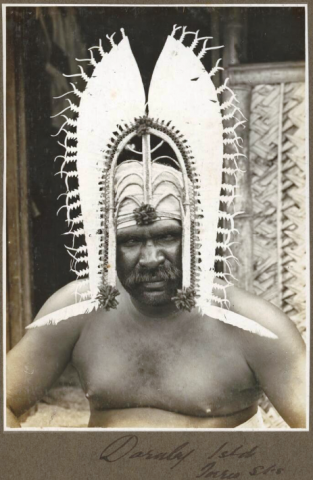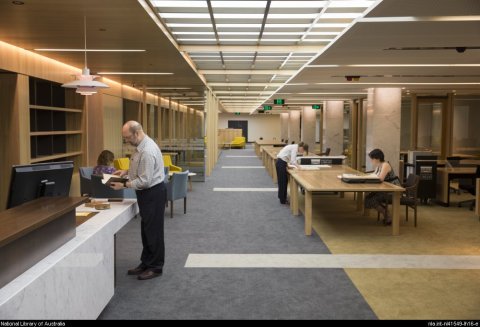Description
The Central Islands comprise Masig, Poruma, Warraber and Yam Islands. The Central Islands cluster has distinct cultural characteristics which define it as a region and people. Masig is otherwise known as Yorke Island. The traditional language of Yorke Island is a local dialect of Kalaw Lagaw Ya. In 1845 Yorke Island people could be found trading from the west of the Straits to the east. Before the arrival of teachers from the London Missionary Society in the 1870s, Yorke Island attracted a diverse community of immigrants, some brought by the pearl and trochus shell industry. Yorke Island is a coral cay situated in the eastern area of the Central Island group in the Torres Strait. The people of Yorke Island are skilled navigators with a detailed knowledge of the reefs who have always occupied a central position in the Straits trading networks.
Poruma is otherwise known as Coconut Island. The island has sea turtle hatcheries, birdlife, a giant clam ground, huge palms, World War Two relics and massive sand flats. The language of Poruma is the Kulkalgau Ya dialect of Kala Lagaw Ya. The ancestors of Coconut Island built their houses out of grass, coconut leaves and trees that floated down from the Fly River jungles of Papua New Guinea.
Warraber is otherwise known as Sue island. The language of Warraber is the Kulkalgau Ya dialect of Kala Lagaw Ya. Situated on a beautiful coral cay, Warraber boasts an abundance of traditional foods such as wongai and coconuts. Many Warraber Islanders still retain strong links to their traditional primal religion, focusing on ancestor worship and respect to the spirits.
Yam is otherwise known as Iama. The language of Iama is Kulkalgau Ya, a dialect of the western-central Torres Strait Language Kala Lagaw Ya. The original inhabitants traded and fought widely in their sailing canoes. In 1792 they came aboard William Bligh's two ships seeking iron. Bligh named Tudu 'Warrior Island' after an attack they later made. The London Missionary Society established a station at Iama's western end making it possible for a permanent village with people settling around the mission. Many of the men took jobs on pearling luggers and a pearling station operated on Tudu during the 1870s. Pacific Islanders working at Nagi station later settled on Iama. During the Second World War many Iama men enlisted in the army.
These distinct cultural and geographical characteristics define the Central Islands as a region and people. The material listed in this section of the guide includes unpublished material such as letters, photographs, paintings and diaries referring to the Islands and people. Please note that the individuals who were interviewed or photographed may not have been in the Central Islands cluster when recorded.
Each Island has been categorized with related material which can be viewed in more detail by clicking on the related link to the Library's catalogue record. If a photo is included a link will also be provided to it's catalogue record.
Masig - Yorke Island
Manuscripts
- Torres Strait Mission related correspondence and Photographs, 1907-1933 (MS 10158)
This collection contains letters exchanged between a local Yorke Island girl, Elma Mosby, and niece of Missionary Reverend William MacFarlane, Grace Wyly. These innocent letters are focused around Elma wanting a bible and life around the Church. It also is an early personal letter from a Torres Strait Islander. The collection also includes photos of well known early Torres strait Islander priests, Lui and Passi, and showing daily life on Thursday Island, Murray Island, Yorke Island and Dauan Island. The photographs in the collection show the erection of the All Saints Church on Erub, an earlier form of dancing equipment, and lifestyles in the early 1900's and the heavy influence of Christianity - Portrait of Edward (Ned) Mosby
Edward (Ned) Mosby was an American seaman on a whaling ship, who jumped ship in the Torres Islands probably in the 1890s and made his way to York Island where he settled, fathering a considerable family whose descendants are still the leading figures on the Island. At one time, he helped the French missionary priests from Thursday Island to the mountainous Kuni region of Yule Island.
Coconut Island - Poruma
Pictures
- Photograph album of Papua and the Torres Strait / Frank Hurley 1921
Frank Hurley (1885-1962) departed Sydney in December 1920 and spent three months among the islands of the Torres Strait. He travelled on to Papua via Daru Island shown from 27 March to 19 August 1921. The islands in this album include Darnley, Mabuaig, Murray and the Thursday Islands and it captures aspects of everyday life for Islanders. All of the images in this album are of people that are yet to be identified. The following photograph is from this album:
Lugger model made by native - Coconut Island
Yam Island - Iama
Oral History
- Gaetano Lui Junior interviewed by Aggie Hankin in the Torres Strait songs project
Lui discusses his own family upbringing on Yam Island and the influence of dance in his life. Lui further dicusses Creole culture, his experiences in politics and the challenges for his community, and the necessity to revive language, dance and culture.
- Ned David interviewed by William Kepa and Karl Neuenfeldt in the Torres Strait songs project
David discusses the influence of dance and song in his life growing up and living on Yam Island. He further discusses the influence of the Gospel in his life and the journey his has taken with his music.
- Roy Kebisu interviewed by Karl Neuenfeldt in the Torres Strait songs project
Kebisu reflects on dancing and the Church on Yam Island and the profound influence it had on him growing up. Outside influences which have greatly affected the maintenance of culture and traditions. Kebisu also discusses being a descendant of King Kebisu from Warrior (Tudu) Island and the family move from Tudu to Yam Island.
- Salu Sebasio interviewed by Aggie Hankin in the Torres Strait songs project
Sebasio discusses the roles which dances and songs have within the community. Particularly the roles individuals had in composing songs, makers of dance equipment and head dancers. She also talks about the lack of respect and diminishing of language that has been evident in her lifetime.
Warraber - Sue Island
Oral History
- Ted Billy interviewed by William Kepa in the Torres Strait song project
Billy reflects on dancing and songs on Warraber and the influence it had on him growing up on the island. He also discusses the influences of Western society and young people's perception of culture compared to his growing up.

[Man wearing head dress], Darnley Island [Erub], Torres Straits [picture] / Frank Hurley 1921

Special collection materials can be accessed through our Special Collections Reading Room located on the first floor of the National Library